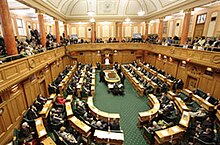
Back مجلس نواب نيوزيلندا Arabic Cámara de Representantes de Nueva Zelanda AST Cambra de Representants de Nova Zelanda Catalan Repræsentanternes hus (New Zealand) Danish Repräsentantenhaus (Neuseeland) German Cámara de Representantes de Nueva Zelanda Spanish مجلس نمایندگان نیوزیلند Persian Chambre des représentants de Nouvelle-Zélande French Predstavnički dom Novog Zelanda Croatian Camera dei rappresentanti (Nuova Zelanda) Italian
House of Representatives | |
|---|---|
| 54th Parliament | |
 | |
| Type | |
| Type | |
| History | |
| Founded | 24 May 1854 (first sitting)[1] |
| Leadership | |
| Structure | |
| Seats | 123 |
 | |
Political groups | Government (68)
Official Opposition (34)
Crossbench (21) |
| Committees | 20 select committees |
Length of term | Up to three years |
| Salary | NZ$163,961[2] |
| Elections | |
| Mixed-member proportional representation | |
First election | 14 July – 1 October 1853 |
Last election | 14 October 2023 |
Next election | On or before 19 December 2026 |
| Meeting place | |
 | |
| Debating Chamber, Parliament House, Wellington | |
| Website | |
| www | |
| Rules | |
| Standing Orders of the House of Representatives, 2020 (English) | |
The House of Representatives (Māori: Whare o Raro, lit. 'Lower House')[3] is the sole chamber of the New Zealand Parliament. The House passes laws, provides ministers to form the Cabinet, and supervises the work of government. It is also responsible for adopting the state's budgets and approving the state's accounts.
The House of Representatives is a democratic body consisting of representatives known as members of parliament (MPs).[4] There are normally 120 MPs, though there are currently 123 due to an overhang. Elections take place usually every three years using a mixed-member proportional representation system, which combines first-past-the-post elected seats with closed party lists. 72 MPs are elected directly in single-member electoral districts and further seats are filled by list MPs based on each party's share of the party vote. A government may be formed from the single party or coalition of parties that has the support of a majority of MPs.[4] If no majority is possible, a minority government can be formed with a confidence and supply arrangement. If a government is unable to maintain the confidence of the House then an early general election can be called.
The House of Representatives was created by the New Zealand Constitution Act 1852 (effective 1853), an act of the British Parliament, which established a bicameral legislature; however the upper chamber, the Legislative Council, was abolished in 1950.[4] Parliament received full control over all New Zealand affairs in 1947 with the passage of the Statute of Westminster Adoption Act. The debating chamber of the House of Representatives is located inside Parliament House in Wellington, the capital city. Sittings of the House are usually open to the public, but the House may at any time vote to sit in private. Proceedings are broadcast through Parliament TV and the AM Network.
- ^ "First sitting, 1854". NZ History. Ministry for Culture and Heritage. 19 August 2014. Retrieved 22 February 2019.
- ^ Cite error: The named reference
salary_2021was invoked but never defined (see the help page). - ^ "Whare o Raro - Te Aka Māori Dictionary". maoridictionary.co.nz. Retrieved 31 January 2023.
- ^ a b c "How Parliament works: What is Parliament?". New Zealand Parliament. 28 June 2010. Retrieved 31 May 2014.